Understanding “Form Follows Function”
One of the fundamental principles in design is the concept of “form follows function.” This means that every shape or design element of an object is created with a purpose. It’s not about making things look good just for the sake of
aesthetics; it’s about ensuring that the form serves the function effectively.
Take, for example, a wheel. It cannot be cubic if it is to function properly on a car. Its circular shape serves the purpose of allowing smooth, continuous motion. Similarly, modern screwdriver handles often feature ridges, which prevent slipping during use. This design is not merely decorative but functional
Practical Design Examples
To illustrate this further, consider scissors. The holes for fingers are immediately recognizable and intuitive, indicating that they are to be held by the fingers and not by the blades. This is a clear example of design serving function. Every form has a specific purpose, and understanding this can significantly enhance one’s design and modeling skills.
Another example is the rounded front of most cars. This design choice is made for aerodynamic efficiency, reducing air resistance and improving fuel economy. Sharp, protruding elements are avoided as they would increase drag and reduce efficiency

Transferring Skills to Modeling
When transitioning from drawing to modeling, it’s essential to learn how to transfer measurements accurately. This skill, often taught in drawing classes, is crucial in ensuring that the proportions in your models are correct. However, this can be challenging if reference materials are scarce or of poor quality.

Dealing with Limited References
If you’re working with limited references, such as low quality images or videos, it’s vital to use whatever is available effectively. Cross-referencing multiple sources, even if they are of varying quality, can help create a more accurate model. Additionally, practicing with simpler objects can help improve your eye for proportions before moving on to more complex projects.

The Importance of Functionality in Design
It’s important to recognize that in the professional world, especially in concept design and industrial modeling, understanding the functionality behind every design is crucial. While some concept artists may focus solely on aesthetics, the most successful ones integrate principles of industrial design and engineering into their work.

Learning from Professional Practice
Engaging with professional designers or taking courses that emphasize both form and function can provide valuable insights. For instance, knowing that older car designs, like the “Chaika” with its sharp chrome edges, were changed primarily for pedestrian safety can reshape how you approach design. Such knowledge helps in reducing errors and creating more effective designs.

Developing Your Skills
Drawing from life, even simple objects, can significantly enhance your understanding of form and proportion. Practicing with primitive shapes and gradually advancing to more complex forms can build a solid foundation. Starting with projects that have plenty of references and gradually increasing the complexity will help develop your skills and eye for detail.

Practical Tips
- Start Simple: Begin with simpler models to build your confidence and skills. Choose projects with abundant reference materials.
- Use Tools Effectively: Set up a studio environment in your modeling software and use basic shapes to transfer key measurements.
- Develop Your Eye: Continuously practice by creating models from references to improve your visual
estimation of proportions. By understanding and applying the principle that “form follows function,” and by progressively building your skills through practice and study, you can overcome challenges in modeling and create designs that are both functional and aesthetically pleasing.
In summary, mastering proportions in modeling involves a blend of traditional drawing skills, consistent practice, reference checking, and continuous learning. By building a strong foundation and gradually tackling more complex projects, one can develop the proficiency needed to create accurate and aesthetically pleasing models